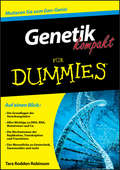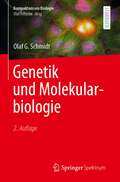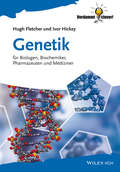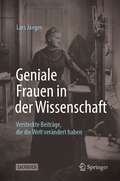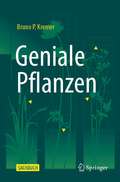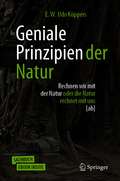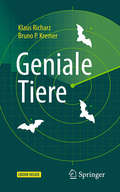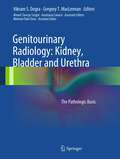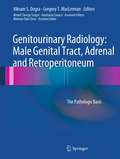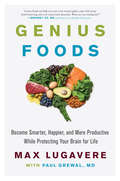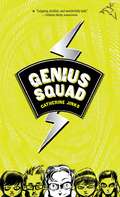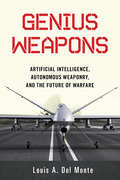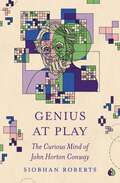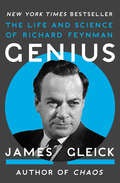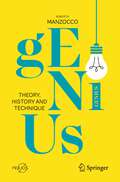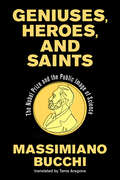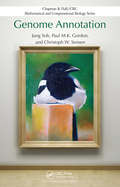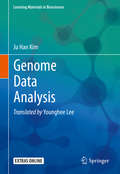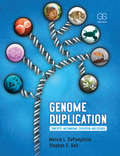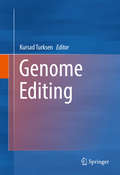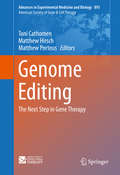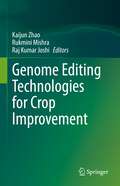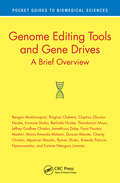- Table View
- List View
Genetik kompakt für Dummies (Für Dummies)
by Tara Rodden RobinsonAuf einen Blick: Die Grundlagen der Vererbungslehre Alles Wichtige zu DNA, RNA, Mutationen und Co. Die Mechanismen der Replikation, Transkription und Translation Das Wesentliche zu Gentechnik, Stammzellen und mehr Ihr Speed-Date mit der Genetik Der schnelle Überblick für Schüler, Studenten und jeden, den es sonst noch interessiert Sie suchen einen kompakten und leicht verständlichen Einstieg in die Genetik? Dann ist dieses Buch genau das richtige für Sie! Es enthält das Wichtigste, das Sie zur Vererbungslehre und ihren Gesetzen wissen müssen. Tara Rodden Robinson erklärt Ihnen, wie die DNA auf - gebaut ist und wie sie kopiert und richtig in Proteine übersetzt wird. Sie erfahren außerdem, was es mit den Mendelschen Regeln, Klonen und Gentechnik auf sich hat, wie Genmutationen und Erbkrankheiten entstehen und vieles mehr. So ist dies Ihr perfekter Nachhilfelehrer für die Tasche: freundlich, kompetent und günstig.
Genetik und Molekularbiologie (Kompaktwissen Biologie)
by Olaf G. SchmidtDer Espresso unter den LehrbüchernKompaktwissen Genetik und Molekularbiologie präsentiert die Inhalte in klarer, prägnanter Darstellung. Ohne unnötigen Ballast und im richtigen Kontext erläutert der Band verständlich die Fakten, Zusammenhänge und Prinzipien dieses wichtigen Teilgebiets der Lebenswissenschaften. Damit eignet er sich besonders… zur Nachbereitung von Vorlesungen und Seminaren … zur Vorbereitung auf Prüfungen… zum Nachschlagen während des späteren Studiums oder im Berufsleben. Das Wichtigste zur Genetik und ihrer Molekularbiologie von Pro- und Eukaryoten Das gesamte Wissen zur Genetik für die Prüfungen bis zum Bachelor oder ersten Staatsexamen in kompakter Form:Das genetische MaterialOrganisation des ErbgutsDNA-ReplikationTranskription und Translation bei Bakterien, Archaeen und EukaryotenRegulation der Genexpression bei ProkaryotenRegulation der Genexpression bei EukaryotenFormale Genetik, Klassische GenetikRekombination, VariabilitätKonjugation, Transduktion, Transformation bei BakterienMutationenDNA-ReparaturmechanismenHumangenetikImmun- und EntwicklungsgenetikGenomikMethoden: von DNA-Isolierung bis Genome Editing und Organ-ChipsModellorganismenDie zweite Auflage wurde durchgehend überarbeitet und um aktuelle Inhalte ergänzt. Erweitert wurden vor allem die Darstellungen zur Architektur des Genoms, seiner Kontrolle und Regulation und die Bedeutung epigenetischer Vorgänge.
Genetik: für Biologen, Biochemiker, Pharmazeuten und Mediziner (Verdammt clever!)
by Hugh Fletcher Ivor Hickey Claudia HorstmannKompakt und »verdammt clever« auf den Punkt gebracht – vermittelt Genetik das unverzichtbare molekulare Grundwissen sowie alles Wichtige zu den Themen Genome, Mechanismen der Vererbung, Humangenetik, Populationsgenetik und Evolution sowie zu den Anwendungen der modernen Genetik. Das ideale Einsteiger-Buch – verständlicher Text, einprägsame Abbildungen und präzise Kapitelzusammenfassungen sind echte Pluspunkte, wenn es um einen schnellen Start in dieses spannende Fach geht. • Das perfekte Kurzlehrbuch! Optimal für eine Einführung in die molekulare Genetik – die wirklich wichtigen Themen werden mit ihren Kernaussagen kurz und knapp behandelt. • Verständliche Darstellung! Jedes Kapitel enthält eine Zusammenfassung der wesentlichen Fakten und Begriffe, klare und leicht erfassbare Abbildungen illustrieren die Inhalte. • Ohne Angst in die Prüfung! Der Textaufbau ermöglicht strukturiertes Lernen und schnelles Wiederholen – zusätzlich mit über 70 Fragen und Antworten zum Üben.
Geniale Frauen in der Wissenschaft: Versteckte Beiträge, die die Welt verändert haben
by Lars JaegerObwohl Frauen schon früh das wissenschaftliche Denken mitgeprägt haben, sichtbar geworden sind sie fast nie. Dieses Ungleichgewicht setzt sich bis heute fort, auch wenn es aktuell weit mehr Wissenschaftlerinnen gibt als jemals zuvor. Lars Jaeger spannt einen Bogen von der Antike bis heute und porträtiert in essayartigen Einführungen das Leben und Wirken der wohl bedeutendsten weiblichen Naturwissenschaftlerinnen und Mathematikerinnen. Von Hypatia von Alexandria über Émilie du Châtelet und Emmy Noether bis hin zu Lisa Randall, sie alle haben Großes geleistet, die Wissenschaft entscheidend vorangebracht und konnten dennoch oft nicht aus dem Schatten ihrer männlichen Kollegen treten.Neben den spannenden Porträts der einzelnen Wissenschaftlerinnen sowie einer detaillierten und anschaulichen Darstellung ihrer wissenschaftlichen Leistungen beleuchtet dieses Sachbuch auch das Geschlechterverhältnis in der Wissenschaft, das sich nur quälend langsam zugunsten eines fairen Verhältnisses für die Frauen entwickelt.
Geniale Pflanzen
by Bruno P. KremerIn diesem Buch finden Sie eine Auswahl erstaunlicher Eigenheiten unserer grünen Mitgeschöpfe, der Pflanzen. Beim bloßen Hinsehen kann man den Eindruck gewinnen, als stünden die Pflanzen einfach nur so herum, aber die genauere Inspektion deckt doch mancherlei Besonderheiten in Gestalt und Funktionen auf. Einer kleinen Umschau im Bereich von Stämmen und Stängeln schließt sich Ungewöhnliches von den Blattorganen an und schließlich beleuchtet der Autor die faszinierenden Aktionsfelder der Blüten bis hin zur Samen- bzw. Fruchtreife. Erfahren Sie beispielsweise, welch geheimnisvolle Stoffschiebereien unsere Waldorchideen im dunklen Untergrund praktizieren, warum die Blätter mancher Pflanzen nachts ziemlich sauer werden, und ob in den imposanten Blütenköpfen der Sonnenblumen eine besondere Mathematik steckt. Pflanzen sind also tatsächlich weitaus spannender, als man zunächst vermutet – mal ganz abgesehen davon, dass sie mit ihrem Stoffwechsel für den Erhalt der gesamten Biosphäre grandiose und geradezu unentbehrliche Dienstleistungen erbringen. Es gibt in unserer grünen Umwelt also eine Menge zu entdecken, und dafür halten Sie gerade ein themenreiches Starterkit in Händen.
Geniale Prinzipien der Natur: Rechnen wir mit der Natur oder die Natur rechnet mit uns [ab]
by E. W. KüppersDieser Band legt den Schwerpunkt auf praktische Anwendungen der Prinzipien, die aus der Natur in unserem Gestaltungsraum übertragen werden können. Er ist dabei getragen von den Regelungs- und Steuerungssystemen, wie sie die Wissenschaft der Kybernetik beschreibt.
Geniale Tiere: Anekdotisches, Bewundernswertes und Erstaunliches aus allen Bereichen unserer Fauna
by Bruno P. Kremer Klaus RicharzVom mikroskopisch kleinen Lebewesen bis zum großen Vierbeiner versetzen uns die meisten Tiere in Erstaunen: Sie können tiefer tauchen, schneller schwimmen, besser laufen oder gar ausdauernd fliegen – physische Leistungsmerkmale, die uns in dieser Perfektion weitgehend fehlen. Noch erstaunlicher sind ihre sensorischen Fähigkeiten: Wer kann schon mit den Ohren sehen oder seine Auserwählte aus einer Distanz von rund 10 km nur mit dem Geruchssinn wahrnehmen? Dieses Buch berichtet über bewundernswerte Eigenheiten und Fähigkeiten von Tieren aller größeren Verwandtschaftsgruppen: Staunen Sie über das reiche Leben zwischen den Sandkörnern des Strandes. Wundern Sie sich über Bienen, die in leeren Schneckenhäusern wohnen. Oder haben Sie je von Tieren gehört, die mit den Füßen fischen? Weitere spannende Themen sind lärmende Meeresfische, dreiäugige Echsen, giftige Vögel und Fledermäuse im Rotlichtmilieu. Mit diesem Wissen wird Ihnen der Gesprächsstoff bei keiner Gelegenheit ausgehen.
Genitourinary Radiology: Kidney, Bladder and Urethra
by Vikram S. Dogra Gregory T. MaclennanA book such as this, correlating radiologic findings with the associated gross and microscopic pathologic findings, has never been offered to the medical community. It contains radiologic images, in a variety of formats (ultrasound, CT scan, MRI scan) correlated with gross photos and photomicrographs of a wide spectrum of pathologic entities, including their variants, occurring in the following organs or anatomic sites. This book would be of particular interest to radiologists and radiologists-in training, who naturally are very cognizant of radiologic abnormalities, but who rarely, if ever, encounter visual images of the pathologic lesions that they diagnose. It will also be of interest to pathologists and pathologists-in-training, urologists, GU radiation oncologists, and GU medical oncologists.
Genitourinary Radiology: Male Genital Tract, Adrenal and Retroperitoneum
by Vikram S. Dogra Gregory T. Maclennan Ahmet Tuncay Turgut Anastasia Canacci Mehmet Ruhi OnurGenitourinary Radiology: Male Genital Tract, Adrenal and Retroperitoneum: The Pathologic Basis is the second volume in a set of books on the pathologic basis of genitourinary radiology. Genitourinary Radiology: Male Genital Tract, Adrenal and Retroperitoneum: The Pathologic Basis provides a lavishly illustrated guide to the radiologic and pathologic features of a broad spectrum of diseases of the male genital tract, adrenal glands and retroperitoneum, including the entities most commonly encountered in day to day practice. The editors are authorities in the fields of genitourinary radiology and pathology, and the authors of each chapter are renowned radiologists, with pathology content provided by an internationally recognized genitourinary pathologist. General, plain film, intravenous pyelography, ultrasound, computed tomography, magnetic resonance imaging, nuclear medicine imaging and PET imaging of each disease entity are included. Accompanying the majority of the radiological narratives are complementary descriptions of the gross and microscopic features of the disease entities. Genitourinary Radiology: Male Genital Tract, Adrenal and Retroperitoneum: The Pathologic Basis is aimed at radiologists in private and academic practice, radiology residents, urologists, urology trainees, pathology trainees and fellows specializing in genitourinary pathology. Both experts and beginners can use this excellent reference book to enhance their skills in the fields of genitourinary radiology and pathology.
Genius Foods: Become Smarter, Happier, and More Productive While Protecting Your Brain for Life
by Max Lugavere Paul GrewalDiscover the critical link between your brain and the food you eat and change the way your brain ages, in this cutting-edge, practical guide to eliminating brain fog, optimizing brain health, and achieving peak mental performance from media personality and leading voice in health Max Lugavere. After his mother was diagnosed with a mysterious form of dementia, Max Lugavere put his successful media career on hold to learn everything he could about brain health and performance. For the better half of a decade, he consumed the most up-to-date scientific research, talked to dozens of leading scientists and clinicians around the world, and visited the country’s best neurology departments—all in the hopes of understanding his mother’s condition. Now, in Genius Foods, Lugavere presents a comprehensive guide to brain optimization. He uncovers the stunning link between our dietary and lifestyle choices and our brain functions, revealing how the foods you eat directly affect your ability to focus, learn, remember, create, analyze new ideas, and maintain a balanced mood. Weaving together pioneering research on dementia prevention, cognitive optimization, and nutritional psychiatry, Lugavere distills groundbreaking science into actionable lifestyle changes. He shares invaluable insights into how to improve your brain power, including the nutrients that can boost your memory and improve mental clarity (and where to find them);the foods and tactics that can energize and rejuvenate your brain, no matter your age;a brain-boosting fat-loss method so powerful it has been called “biochemical liposuction”; andthe foods that can improve your happiness, both now and for the long term.With Genius Foods, Lugavere offers a cutting-edge yet practical road map to eliminating brain fog and optimizing the brain’s health and performance today—and decades into the future.
Genius Kitchen: Over 100 Easy and Delicious Recipes to Make Your Brain Sharp, Body Strong, and Taste Buds Happy (Genius Living #3)
by Max LugavereCombining the dietary recommendations in his bestselling Genius Foods and the lifestyle recommendations of The Genius Life, Genius Kitchen features shockingly delicious, nutrient-packed recipes that will energize your mind, strengthen your body, and pave a path to health that you’ll feel with the first bite. Max Lugavere’s debut book Genius Foods was groundbreaking, providing much-needed information on brain health that was embraced by thousands, and became an instant New York Times bestseller. His second book, The Genius Life, introduced an easy-to-implement protocol for strengthening your body and mind. This is the follow-up fans have been waiting for: the companion cookbook, filled with over 100 delicious recipes to help you lose weight, feel great, and reach optimum health.Inspired by traditions from around the globe, the 100-plus recipes and stunning photographs in Genius Kitchen feature an international twist, with bold flavors that favor simplicity and quality of ingredients over complexity and quantity. In addition, Max lists the basic, healthy ingredients and tools that are essential for a well-stocked kitchen and pantry, and offers techniques and best practices for healthy cooking and eating well on a budget. Max wants everyone to be well and enjoy great food—a legacy imparted on him by the tragic health of his mother. Part cookbook, part wellness guide, Genius Kitchen provides key insights that make healthy eating a breeze. Max explains the importance of whole, fresh foods, how various nutrients work together keep you healthy, and how to get fit without counting calories. Breaking down each meal component, Max explains the art and science of nutrition without the dogma, so that you can feel your best every day without sacrificing your love of eating. Whether you are a novice cook or seasoned in the kitchen; just beginning the journey to wellness, or health conscious but wanting to up your game, everyone will benefit from the information presented in Genius Kitchen—and enjoy some epic food in the process.
Genius Squad
by Catherine JinksNow that the Axis Institute for World Domination has been blown up; the founder, Dr. Phineas Darkkon, has died; and Prosper English (who enrolled Cadel in the first place) is in jail for myriad offenses, Cadel Piggott has round-the-clock surveillance so he'll be safe until he testifies against Prosper English. But nobody seems to want Cadel. Not Fiona, his social worker; not Saul Greeniaus, the detective assigned to protect him. When he is approached by the head of Genius Squad--a group formed to investigate GenoME, one of Darkkon's pet projects--Cadel is dubious Genius Squad can offer him a real home and all the technology his heart desires. But why can't he bring himself to tell Saul what the group is really up to? And how can Genius Squad protect Cadel once Prosper English breaks out of jail?
Genius Weapons: Artificial Intelligence, Autonomous Weaponry, and the Future of Warfare
by Louis A. Del MonteA technology expert describes the ever-increasing role of artificial intelligence in weapons development, the ethical dilemmas these weapons pose, and the potential threat to humanity.Artificial intelligence is playing an ever-increasing role in military weapon systems. Going beyond the bomb-carrying drones used in the Afghan war, the Pentagon is now in a race with China and Russia to develop "lethal autonomous weapon systems" (LAWS). In this eye-opening overview, a physicist, technology expert, and former Honeywell executive examines the advantages and the potential threats to humanity resulting from the deployment of completely autonomous weapon systems. Stressing the likelihood that these weapons will be available in the coming decades, the author raises key questions about how the world will be impacted. Though using robotic systems might lessen military casualties in a conflict, one major concern is: Should we allow machines to make life-and-death decisions in battle? Other areas of concern include the following: Who would be accountable for the actions of completely autonomous weapons--the programmer, the machine itself, or the country that deploys LAWS? When warfare becomes just a matter of technology, will war become more probable, edging humanity closer to annihilation? What if AI technology reaches a "singularity level" so that our weapons are controlled by an intelligence exceeding human intelligence?Using vivid scenarios that immerse the reader in the ethical dilemmas and existential threats posed by lethal autonomous weapon systems, the book reveals that the dystopian visions of such movies as The Terminator and I, Robot may become a frightening reality in the near future. The author concludes with concrete recommendations, founded in historical precedent, to control this new arms race.
Genius at Play: The Curious Mind of John Horton Conway
by Siobhan RobertsA multifaceted biography of a brilliant mathematician and iconoclastA mathematician unlike any other, John Horton Conway (1937–2020) possessed a rock star&’s charisma, a polymath&’s promiscuous curiosity, and a sly sense of humor. Conway found fame as a barefoot professor at Cambridge, where he discovered the Conway groups in mathematical symmetry and the aptly named surreal numbers. He also invented the cult classic Game of Life, a cellular automaton that demonstrates how simplicity generates complexity—and provides an analogy for mathematics and the entire universe. Moving to Princeton in 1987, Conway used ropes, dice, pennies, coat hangers, and the occasional Slinky to illustrate his winning imagination and share his nerdish delights. Genius at Play tells the story of this ambassador-at-large for the beauties and joys of mathematics, lays bare Conway&’s personal and professional idiosyncrasies, and offers an intimate look into the mind of one of the twentieth century&’s most endearing and original intellectuals.
Genius: The Life and Science of Richard Feynman
by James GleickNew York Times Bestseller: This life story of the quirky physicist is &“a thorough and masterful portrait of one of the great minds of the century&” (The New York Review of Books). Raised in Depression-era Rockaway Beach, physicist Richard Feynman was irreverent, eccentric, and childishly enthusiastic—a new kind of scientist in a field that was in its infancy. His quick mastery of quantum mechanics earned him a place at Los Alamos working on the Manhattan Project under J. Robert Oppenheimer, where the giddy young man held his own among the nation&’s greatest minds. There, Feynman turned theory into practice, culminating in the Trinity test, on July 16, 1945, when the Atomic Age was born. He was only twenty-seven. And he was just getting started. In this sweeping biography, James Gleick captures the forceful personality of a great man, integrating Feynman&’s work and life in a way that is accessible to laymen and fascinating for the scientists who follow in his footsteps.
Genius: Theory, History and Technique (Springer Praxis Books)
by Roberto ManzoccoGenius is a fascinating topic. Everyone has an opinion on it, but not a lot of clarity. Much has been written on the subject - biographies, autobiographies, technical books, popular science books, and practical manuals - but genius in all of its dimensions has yet to be addressed. This book seeks to remedy that. What follows is a work of significant breadth that hopes to facilitate a nuanced popular understanding of the definition of genius, examining all of the main theories and approaches regarding the nature and origin of brilliance, the cognitive path that geniuses follow, and the difference that exists between “geniuses” on one side and “normal people” on the other. Pragmatic indications surrounding this issue are also examined, regarding such questions as: is it possible to become a genius or is genius innate? If it is possible, what is the path – no doubt long and difficult – that one must take? Is there a method for becoming a genius that can be taught and learned? This book will appeal to anyone who has ever contemplated great ideas and works and wondered how they came into being.
Geniuses, Heroes, and Saints: The Nobel Prize and the Public Image of Science
by Massimiano BucchiA rich account of the world&’s leading science prize told through the lives it has changed, the controversies it has generated, and the impact it has made on the public.In a world where the work of science largely remains inscrutable to the general public, the Nobel Prize confers a degree of intelligibility like no other honor. Our best-known and most prestigious award for individual scientific achievement, the Nobel attaches a brilliant face to a story of profound discovery, making moving headlines. In Geniuses, Heroes, and Saints, Massimiano Bucchi tells an equally compelling story of the Nobel&’s transformation of science into an epic pursuit legible both to the field and to the public, bound up with the currents of historical change.Three main narratives characterize the Nobel. The scientist as genius, portrayed as a creative visionary, an exceptional intellect reflecting a solitary and romantic ideal of great communicative impact. The scientist as national hero acts as a surrogate of competition among nations in a peaceful, rational contest. The scientist as saint shines with moral exceptionality, a figure worthy of celebration and worship, known for virtues such as modesty, humility, and total dedication, body and soul, to the scientific enterprise. Whether the recipient was Albert Einstein or a countryside doctor toiling for years in obscurity, whether the prize was worthily given or awarded to work later disproved, or whether we even remember the honorees today, the Nobel defined the image of science in the twentieth century, Bucchi shows, an image that still lives in all sorts of fascinating ways today.
Genome Annotation (Chapman & Hall/CRC Computational Biology Series #46)
by Christoph W. Sensen Jung Soh Paul M.K. GordonThe success of individualized medicine, advanced crops, and new and sustainable energy sources requires thoroughly annotated genomic information and the integration of this information into a coherent model. A thorough overview of this field, Genome Annotation explores automated genome analysis and annotation from its origins to the challenges of next-generation sequencing data analysis.The book initially takes you through the last 16 years since the sequencing of the first complete microbial genome. It explains how current analysis strategies were developed, including sequencing strategies, statistical models, and early annotation systems. The authors then present visualization techniques for displaying integrated results as well as state-of-the-art annotation tools, including MAGPIE, Ensembl, Bluejay, and Galaxy. They also discuss the pipelines for the analysis and annotation of complex, next-generation DNA sequencing data. Each chapter includes references and pointers to relevant tools. As very few existing genome annotation pipelines are capable of dealing with the staggering amount of DNA sequence information, new strategies must be developed to accommodate the needs of today’s genome researchers. Covering this topic in detail, Genome Annotation provides you with the foundation and tools to tackle this challenging and evolving area. Suitable for both students new to the field and professionals who deal with genomic information in their work, the book offers two genome annotation systems on an accompanying downloadable resources.
Genome Data Analysis (Learning Materials in Biosciences)
by Ju Han KimThis textbook describes recent advances in genomics and bioinformatics and provides numerous examples of genome data analysis that illustrate its relevance to real world problems and will improve the reader’s bioinformatics skills. Basic data preprocessing with normalization and filtering, primary pattern analysis, and machine learning algorithms using R and Python are demonstrated for gene-expression microarrays, genotyping microarrays, next-generation sequencing data, epigenomic data, and biological network and semantic analyses. In addition, detailed attention is devoted to integrative genomic data analysis, including multivariate data projection, gene-metabolic pathway mapping, automated biomolecular annotation, text mining of factual and literature databases, and integrated management of biomolecular databases. The textbook is primarily intended for life scientists, medical scientists, statisticians, data processing researchers, engineers, and other beginners in bioinformatics who are experiencing difficulty in approaching the field. However, it will also serve as a simple guideline for experts unfamiliar with the new, developing subfield of genomic analysis within bioinformatics.
Genome Duplication
by Melvin DePamphilis Stephen D. BellGenome Duplication provides a comprehensive and readable overview of the underlying principles that govern genome duplication in all forms of life, from the simplest cell to the most complex multicellular organism.?Using examples from the three domains of life - bacteria, archaea, and eukarya - Genome Duplication shows how all living organisms store their genome as DNA and how they all use the same evolutionary-conserved mechanism to duplicate it: semi-conservative DNA replication by the replication fork. The text shows how the replication fork determines where organisms begin genome duplication, how they produce a complete copy of their genome each time a cell divides, and how they link genome duplication to cell division.?Genome Duplication explains how mistakes in genome duplication are associated with genetic disorders and cancer, and how understanding genome duplication, its regulation, and how the mechanisms differ between different forms of life, is critical to the understanding and treatment of human disease.
Genome Editing
by Kursad TurksenThis timely volume explores the use of CRISPR-Cas9 for genome editing, presenting cutting-edge techniques and their applications in treatment of disease. The chapters describe latest methods such as use of targetable nucleases, investigation of the non-coding genome, mouse genome editing, increasing of knock-in efficiency in mouse zygotes, and generation of reporter stem cells; the text contextualizes these methods in treatment of cardiovascular disease, diabetes mellitus, retinitis pigmentosa, and others. The final chapters round out the book with a discussion of controversies and future directions. Genome Editing is an essential, of-the-moment contribution to this rapidly growing field. Drawing from a wealth of international perspectives, it presents novel techniques and applications for the engineering of the human genome. This book is essential reading for all clinicians and researchers in stem cells, regenerative medicine, genomics, biochemical and biomedical engineering- especially those interested in learning more about genome editing and applying it in a targeted, specific way.
Genome Editing
by Toni Cathomen Matthew Hirsch Matthew PorteusThis comprehensive volume explores human genetic engineering its pre-clinical and clinical applications, current developments, and as treatment for hereditary diseases. It presents and evaluates the most recent advances in the understanding of mammalian host DNA repair mechanisms, such as double-strand break induced gene targeting and mutagenesis, the development of zinc-finger nucleases, genome editing for neuromuscular diseases, phase integrases, triplex forming oligonucleotides and peptide nucleic acids, aptamer-guided gene targeting, AAV gene editing via DSB repair, engineered nucleases and trinucleotide repeat diseases, and creation of HIV-resistant cells. The expertly authored chapters contextualize current developments within the history of genome editing while also discussing the current and potential safety concerns of this rapidly growing field. Genome Editing: The Next Step in Gene Therapy, the latest volume in the American Society of Gene and Cell Therapy series, deftly illuminates the potential of genetic engineering technology to eradicate today's deadliest and most prolific diseases. It is ideal reading for clinicians and researchers in genetics and immunology.
Genome Editing Technologies for Crop Improvement
by Kaijun Zhao Rukmini Mishra Raj Kumar JoshiThis book compiles the relevant information related to genome editing tools and their roles in crop improvement. The book contains a brief introduction about various genome editing tools and their application in major crops. It discusses the genome editing approaches and the strategies used for genome editing in different crops. Some of the chapters cover the detailed methodology of sgRNA design, vector construction and transformation in different crops followed by data analysis. A few chapters focus on the applications of genome editing tools towards crop improvement. This book will be of particular interest to plant biologists working in the field of genome editing and crop breeders. It will provide valuable information and useful material for our readers’ experimental work.
Genome Editing Tools and Gene Drives: A Brief Overview (Pocket Guides to Biomedical Sciences)
by Reagan Mudziwapasi Ringisai Chekera Clophas Zibusiso Ncube Irvonnie Shoko Berlinda Ncube Thandanani Moyo Jeffrey Godfrey Chimbo Jemethious Dube Farai Faustos Mashiri Moira Amanda Mubani Duncan Maruta Charity Chimbo Mpumuzi Masuku Ryman Shoko Rutendo Patricia Nyamusamba Fortune Ntengwa JomaneGenome-editing methods are becoming routine tools for molecular and cell biologists. Such tools include ZFNs, CRISPR, megaTALs and TALENs. These tools are revolutionizing the creation of precisely manipulated genomes to modify the characteristics of organisms or cells. Additionally, gene drives have altered the way we understand inheritance laws. They give us the ability to have total control of the inheritance of traits of choice and importance. This succinct volume summarizes the history, principles and applications – as well as the advantages and disadvantages – of each of these tools and various kinds of gene drives. The book is part of a program to produce books helpful to students and faculties of science at colleges and universities. This volume in the Pocket Guides to Biomedical Sciences series will help demystify these technologies. The book fills the gap between established conventional methods and the novel and exciting newly introduced tools of genome editing and gene drives. It will help young scientists understand the emerging genome-editing tools and gene drives, thereby promoting related research and adoption. Key Features Extensively reviews the current genome-editing tools and gene drives Clarifies the targeting mechanisms and specificity of genome-editing tools Details many different types of natural and synthetic gene drives Highlights concerns with gene drives and genome-editing tools Related Titles Brown, T. A. Genomes 4 (ISBN 978-0-8153-4508-4) Samuelsson, T. The Human Genome in Health and Disease: A Story in Four Letters (ISBN 978-0-8153-4591-6) Soh, J., et al. Genome Annotation (ISBN 978-1-4398-4117-4)
Genome Editing and Biological Weapons: Assessing the Risk of Misuse
by Katherine ParisThis monograph introduces current genome editing technologies—clustered regularly interspaced short palindromic repeat (CRISPR)-CRISPR-associated (Cas) systems, transcription activator-like effector nucleases (TALENs), and zinc-finger nucleases (ZFNs)—and provides an assessment of the risk of misuse of these technologies based on the following parameters: accessibility, ease of misuse, magnitude of potential harm, and imminence of potential misuse. The findings from this assessment are applied to analyze and evaluate the threat posed by the intentional misuse of genome editing technologies to develop biological weapons. Furthermore, the book discusses the implications of misuse for different applications of genome editing, such as making existing pathogens more dangerous, modifying the human microbiome, weaponizing gene drives, engineering super soldiers, and augmenting the general population to confer economic advantages. Technologies that enable genome editing with programmable nucleases—including CRISPR, TALEN, and ZFN—allow for the precise genetic modification of organisms and cultured cells. While these technologies are used for a variety of beneficial applications, intelligence and defense experts have raised concerns that genome editing technologies, especially CRISPR, could be misused to develop new and improved biological weapons. Furthermore, experts worry that the number and type of actors who could potentially misuse genome editing is dramatically increasing given the democratization of biology, which is allowing biology to become more accessible to everyone including nonexperts. The book provides a comprehensive assessment of how feasible it is for users with different levels of knowledge and skill to acquire and then to apply the technologies to develop a biological weapon. It also provides an assessment of governability and a tailored set of recommendations that address security concerns. These recommendations are sensitive to the cost-benefit trade-off of regulating genome editing technologies. The book targets researchers as well as intelligence analysts, defense and security personnel, and policymakers.
